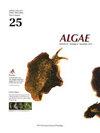Physiological response of red macroalgae Pyropia yezoensis (Bangiales, Rhodophyta) to light quality: a short-term adaptation
IF 2.4
3区 生物学
Q1 MARINE & FRESHWATER BIOLOGY
引用次数: 0
Abstract
Light quality is a common environmental factor which influences the metabolism of biochemical substances in algae and leads to the response of algal growth and development. Pyropia yezoensis is a kind of economic macroalgae that naturally grows in the intertidal zone where the light environment changes dramatically. In the present study, P. yezoensis thalli were treated under white light (control) and monochromatic lights with primary colors (blue, green, and red) for 14 days to explore their physiological response to light quality. During the first 3 days of treatment, P. yezoensis grew faster under blue light than other light qualities. In the next 11 days, it showed better adaptation to green light, with higher growth rate and photosynthetic capacity (reflected by a higher rETRmax = 61.58 and Ek = 237.78). A higher non-photochemical quenching was observed in the treatment of red light than others for 14 days. Furthermore, the response of P. yezoensis to light quality also results in the difference of photosynthetic pigment contents. The monochromatic light could reduce the synthesis of all pigments, but the reduction degree was different, which may relate to the spectral absorption characteristics of pigments. It was speculated that P. yezoensis adapted to a specific or changing light environments by regulating the synthesis of pigments to achieve the best use of light energy in photosynthesis and premium growth and metabolism.大型红藻Pyropia yezoensis(Bangiales,Rhodophyta)对光照质量的生理反应:短期适应
光质量是影响藻类体内生化物质代谢并导致藻类生长发育响应的常见环境因子。叶藻(Pyropia yezoensis)是一种天然生长在光环境变化剧烈的潮间带的大型经济藻类。本研究采用白光(对照)和单色光(蓝、绿、红)处理紫杉菌体14 d,探讨其对光质量的生理反应。在处理的前3天,蓝光处理下紫杉的生长速度快于其他光处理。在接下来的11天里,它对绿光的适应能力更强,生长速度和光合能力更高(rETRmax = 61.58, Ek = 237.78)。在14天内,红光处理的非光化学猝灭率高于其他处理。此外,紫杉树对光质量的响应也导致了光合色素含量的差异。单色光对所有色素的合成均有抑制作用,但抑制程度不同,这可能与色素的光谱吸收特性有关。推测紫杉通过调节色素的合成来适应特定的或不断变化的光环境,从而实现光能在光合作用中的最佳利用和优质的生长代谢。
本文章由计算机程序翻译,如有差异,请以英文原文为准。
求助全文
约1分钟内获得全文
求助全文
来源期刊

Algae
PLANT SCIENCES-
CiteScore
5.10
自引率
25.00%
发文量
18
期刊介绍:
ALGAE is published by the Korean Society of Phycology and provides prompt publication of original works on phycology. ALGAE publishes articles on all aspects of phylogenetics and taxonomy, ecology and population biology, physiology and biochemistry, cell and molecular biology, and biotechnology and applied phycology. Checklists or equivalent manu-scripts may be considered for publication only if they contribute original information on taxonomy (e.g., new combinations), ecology or biogeography of more than just local relevance. Contributions may take the form of Original Research Articles, Research Notes, Review Articles and Book Reviews.
 求助内容:
求助内容: 应助结果提醒方式:
应助结果提醒方式:


